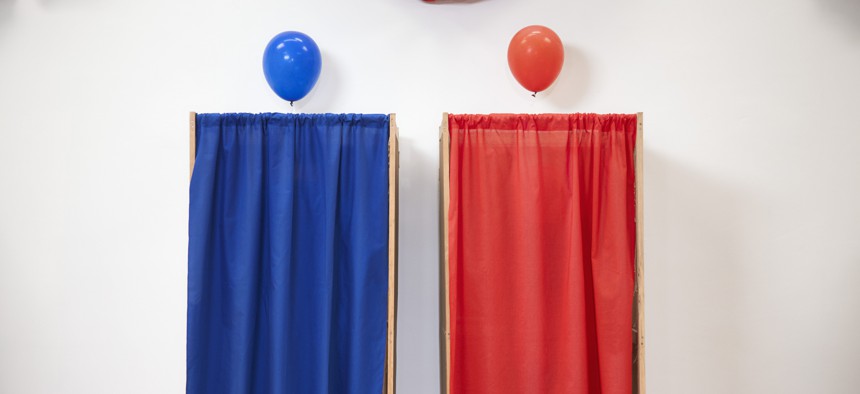The Curse of Straight-ticket Voting

Hill Street Studios via Getty Images
COMMENTARY | The wave that hit state government elections this year had mostly to do with cementing single party control. It’s a trend that’s keeping good candidates on the sidelines, flawed ones in office and eroding checks on power.
This week’s elections didn’t bring the big red wave that was supposed to entrench Republican majorities in both houses of Congress. But it did bring dozens of smaller waves, both red and blue, that swept defective candidates into state offices and kept good ones out.
The result: statehouses are perhaps as monolithic as ever, with fewer checks and balances on the majority party’s power.
Take Texas, for example. No Democrat has been elected to statewide office since 1994, but the party should have had a shot against Attorney General Ken Paxton, who has been under felony indictment for alleged securities fraud since 2015, faced numerous whistleblower complaints from within his own office, and led a frivolous effort to overturn the 2020 presidential election. On Tuesday, however, the scandal-plagued lawman coasted to a third term, underperforming Gov. Greg Abbott by less than a percentage point. The story was much the same for all seven statewide offices on the Texas ballot: Republicans winning by around 10 percentage points or more.
The wave went in the opposite direction in California. There, Gov. Gavin Newsom’s blowout victory was replicated by other Democrats on the ballot. Democrat Malia Cohen prevailed in the race for state controller by a slightly narrower margin over Republican Lanhee Chen, a moderate who picked up endorsements from Democrats including former presidential candidate Andrew Yang and the liberal editorial boards of the Los Angeles Times and the San Francisco Chronicle. “California needs an independent fiscal watchdog,” the Times editorialized in its only endorsement of a Republican for one of the eight statewide offices.
No matter. Even California, which prides itself on taking partisanship out of redistricting and local elections, couldn’t break the curse of straight-ticket voting.
The two most populous states are both vast, diverse and politically heterogeneous, but they share the quality of being one-party states. This couldn’t have been what their framers had in mind when they created an array of independently elected statewide offices, like insurance commissioner in California or railroad commissioner in Texas. Many of these offices, particularly attorney general and controller, can provide important checks on the party and governor in power. Unbroken single-party control neuters these checks.
State legislatures in California and Texas also are controlled by the same party that occupies the governor’s office. This week’s elections will reduce the number of states, currently 12, where the party in power in the governor’s office does not have unified control of the legislature. Voters in Minnesota and Michigan handed Democrats control of both the executive and legislative branches, while Maryland and Massachusetts replaced their retiring moderate Republican governors with Democrats, bringing them into line with legislative majorities. As recently as 2010, nearly half of states had different parties in control of the governor’s office and legislature.
Maryland’s Democratic wave, following eight years of the popular moderate Republican Gov. Larry Hogan, was predestined when Republicans nominated a far-right extremist to head their ticket. Hogan declined to endorse fellow Republican Dan Cox to succeed him, calling him a “QAnon whack job,” but Hogan did endorse Republican Barry Glassman for state comptroller, as did the liberal editorial board of The Washington Post. Glassman, however, found himself buried in the rubble of Cox’s doomed campaign, handing Democrats all the levers of power in Maryland.
One could argue that single-party control reduces strife and partisan gamesmanship in state government, leading to better policy outcomes. But many of the most noteworthy accomplishments in state government, such as health care reforms that expand care while respecting free-market principles, came through bipartisan compromise. And state governments under one-party rule can become hotbeds of corruption, such as previous administrations in New York and Ohio.
There’s also little reason to believe that voters are happy with single-party dominance of state governments, even as their ballots entrench it. The percentage of voters expressing a positive view of state government declined by 5 percentage points between 2019 and this year, even as the number of states under single-party rule increased, according to Pew Research Center. That said, confidence in state government remains far ahead of that of the notoriously divided federal government. When the healthy give-and-take over policymaking sours into gridlock and partisan warfare, voters lose faith in the process.
The solution isn’t for state governments to model themselves after Washington, D.C., or even to make the governor the only state official elected statewide, like in New Jersey, or adopt Nebraska’s unicameral, ostensibly nonpartisan legislature. Reducing or eliminating legislative gerrymandering would make legislatures more competitive and responsive to voters. Reducing the number of statewide elected offices in states with large numbers of them, particularly those with elected supreme courts, would reduce ballot fatigue and help voters judge candidates on their merits rather than as part of a partisan slate. And the rest would be up to the voters themselves, who, to borrow an axiomatic statement, would get the government they deserve.
James Nash, a senior vice president at ROKK Solutions, is a former statehouse reporter in Ohio, California and New Jersey who most recently served as the press secretary for the bipartisan National Governors Association.
NEXT STORY: Democrats Win Full Control of Government in More States





